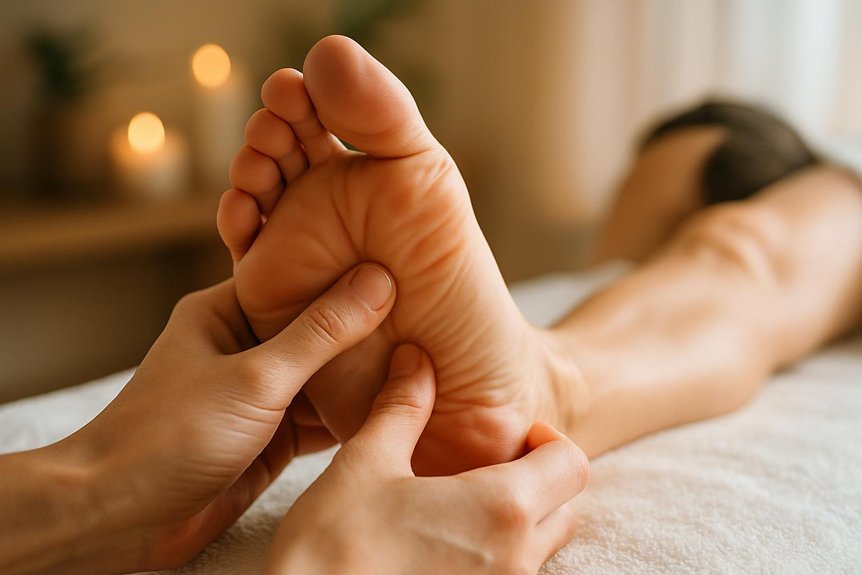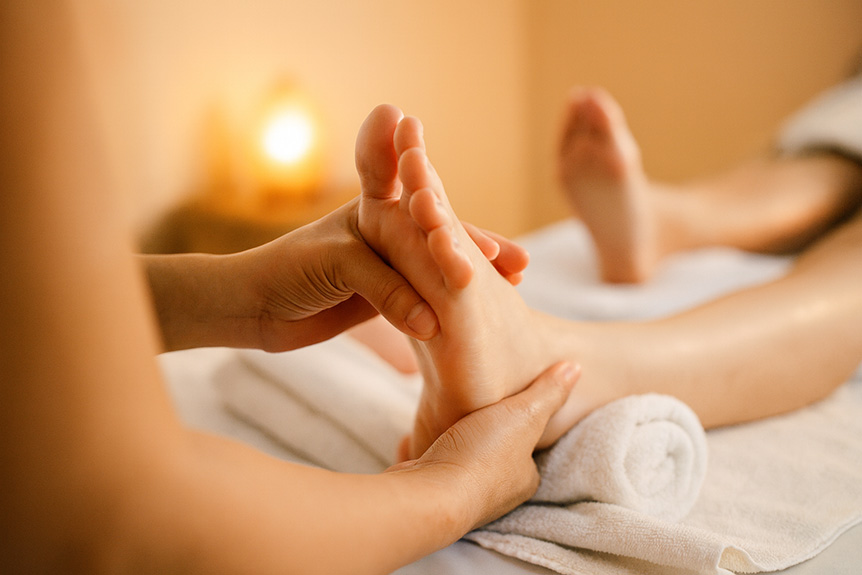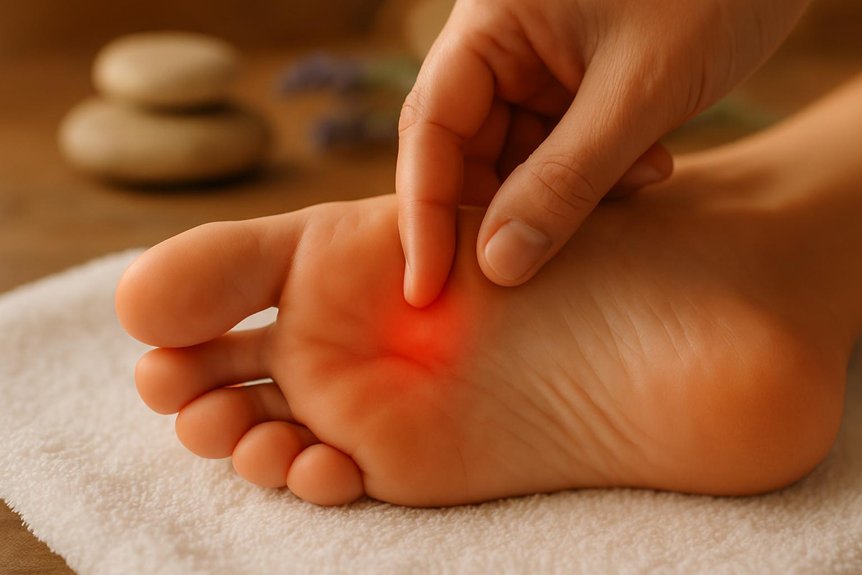When a pressure point hurts, it usually indicates increased neural sensitivity, local muscle tension, or an underlying imbalance in the corresponding organ or body system. This discomfort is a normal response as nerve endings are stimulated and may reflect temporary physiological stress or congestion. Mild tenderness often resolves within 24–48 hours and is generally not a cause for concern. Continued exploration of the causes, management strategies, and when to seek help can provide a clearer understanding of these sensations.
Understanding Pressure Points and Their Sensitivity

A pressure point refers to a specific area on the feet, hands, or ears that corresponds to organs, glands, or systems within the body. Each of these points is mapped according to established pressure charts and is believed to serve as a conduit for communication between external touch and internal physiological responses.
Sensitivity at a pressure point may indicate increased neural or circulatory responsiveness in the associated region. At Spa & Massage, therapists use gentle, precise pressure to assess sensitivity, always respecting individual thresholds.
Variations in sensitivity can result from numerous factors, including local tension or systemic imbalances. Recognising these nuances allows therapists to tailor sessions, facilitating a more personalised and supportive experience, and ensuring that each client’s comfort and wellbeing remain paramount.
Practitioners often emphasise the healing power of reflexology as a means to promote balance and holistic health throughout the body.
Common Reasons for Discomfort During this Massage Technique
Discomfort during this massage may arise from heightened sensitivity in nerve endings, localized tension or energy blockages, and underlying health imbalances.
Each of these factors can influence how an individual perceives pressure on specific reflex points. Recognizing these common causes allows therapists at Spa & Massage to tailor treatments for ideal comfort and effectiveness.
Sensitivity and Nerve Endings
Why do certain pressure points elicit a sharper response than others? The answer often lies in the intricate distribution of nerve endings across the feet and hands. Some areas contain a higher density of sensory receptors, making them more susceptible to pressure and touch.
When a reflexologist applies targeted stimulation, these concentrated nerve clusters transmit signals rapidly to the central nervous system, sometimes resulting in acute or heightened sensations.
At Spa & Massage, therapists are trained to recognise these sensitive points and adjust their technique accordingly, ensuring client comfort and safety. Sensitivity at specific pressure points is a normal physiological response, not necessarily an indicator of underlying pathology.
Understanding individual nerve sensitivity allows therapists to deliver personalised care, enhancing both therapeutic efficacy and client trust.
Tension and Energy Blockages
Beyond heightened nerve sensitivity, tension and energy blockages frequently underlie discomfort experienced during massage sessions.
Clinically, localized tension refers to areas where muscles or connective tissues are contracted or restricted, often as a result of stress, physical strain, or postural habits.
In this massage, these areas may correspond to specific points on the feet or hands, and applying pressure can temporarily intensify sensations of discomfort.
Energy blockages, as described in holistic practice, are thought to impede the smooth flow of essential energy along pathways within the body.
At Spa & Massage, therapists are trained to identify and gently address these zones, employing tailored pressure techniques to promote relaxation and restore natural flow.
Clients often report a sense of release and improved ease following such focused interventions.
Underlying Health Imbalances
A notable factor contributing to discomfort during massage session is the presence of underlying health imbalances within the body. When pressure points elicit pain or sensitivity, it may suggest functional disturbances or stress in corresponding organs or systems.
Clinical observation supports the concept that reflex zones mirror internal states; for example, tenderness in a point linked to the digestive tract could indicate digestive irregularities. At Spa & Massage, therapists are trained to recognise these signs and adapt treatments accordingly, focusing on client comfort and holistic support.
Interpreting Pain: What Your Body Might Be Telling You

When discomfort is experienced during session, it may indicate underlying imbalances or tension within specific organs or systems corresponding to the reflex points.
Clinically, pain or tenderness can serve as a signal from the nervous system, highlighting areas where physiological stress or congestion may be present.
Spa & Massage therapists recognise that zone therapy is not simply a relaxation technique but a diagnostic tool, offering valuable insight into the body’s state of health.
Not every sensation is cause for concern; however, recurring or pronounced discomfort at certain points can reflect chronic tension, inflammation, or circulatory issues.
How Our Therapists Address Sensitive Pressure Points
At Spa & Massage, therapists systematically address sensitive pressure points using gentle pressure adjustments to minimise discomfort while maintaining therapeutic efficacy.
Each session is tailored through personalised massage techniques based on the client’s feedback and clinical presentation.
This approach is supported by evidence indicating that individualised care enhances both client comfort and treatment outcomes.
Gentle Pressure Adjustments
Because pressure points can sometimes elicit discomfort due to heightened sensitivity or underlying tension, Spa & Massage therapists employ gentle pressure adjustments as a central technique. This approach involves the careful modulation of finger or thumb pressure in response to client feedback and observed cues.
By gradually reducing intensity when tenderness is detected, therapists ensure that the client’s experience remains therapeutic rather than painful. Adjustments are grounded in anatomical knowledge and clinical observation, allowing for the release of tension without exacerbating discomfort.
Attention to subtle physical responses—such as muscle contraction or changes in breathing—guides the therapist’s technique. This clinical sensitivity fosters trust and relaxation, reinforcing Spa & Massage’s commitment to delivering effective, safe, and compassionate therapy care in a calming, supportive environment.
Personalised Massage Techniques
A personalised approach to zone therapy is central to the practice at Spa & Massage, particularly when addressing sensitive pressure points. Therapists conduct a detailed consultation to identify areas of discomfort, medical history, and client preferences.
This assessment allows precise mapping of reflex zones, ensuring techniques are tailored to individual needs. When a pressure point elicits pain, therapists may adapt pressure, alter stroke techniques, or integrate supportive modalities such as gentle stretching or warm compresses.
These modifications are grounded in evidence-based practice, aiming to promote relaxation and optimise therapeutic responses without exacerbating sensitivity. Continuous feedback from the client guides session adjustments.
This attentive, client-specific approach fosters trust and supports holistic wellbeing, distinguishing the massage experience at Spa & Massage as both clinical and compassionate.
Tips for Managing Tenderness After a Massage Session
Following a massage session, it is not uncommon for clients to experience localized tenderness or mild discomfort at certain reflex points. This reaction is typically transient and may reflect the body’s natural response to stimulation of underlying tissues.
At Spa & Massage, therapists recommend gentle self-care measures, such as applying a cool compress to the affected area or engaging in light stretching to facilitate circulation.
Hydration is also encouraged, as it assists with metabolic waste removal following treatment.
Clients are advised to avoid vigorous physical activity for several hours post-session to allow tissues to recover.
Applying a neutral, non-scented moisturizer, as used in our clinics, may further soothe sensitive skin.
These evidence-based strategies support ideal comfort and integration of massage therapeutic effects.
When to Seek Further Advice From a Wellness Professional

Should tenderness at pressure points persist beyond 48 hours, intensify, or be accompanied by symptoms such as swelling, numbness, or persistent pain, it may indicate an atypical response requiring professional evaluation.
Clients experiencing these signs are advised to consult a qualified wellness professional to rule out underlying conditions or adverse reactions.
At Spa & Massage, therapists are trained to identify when discomfort exceeds normal post-session responses and may recommend pausing massage treatments until further assessment.
Clinical evidence suggests that persistent or worsening symptoms should not be ignored, as early intervention can prevent complications.
Open communication about symptoms helps therapists tailor care safely and effectively.
Seeking advice ensures the client’s wellbeing remains the central focus throughout the massage experience.
Conclusion
Ironically, the very discomfort clients seek to avoid in massage sessions may be the body’s most candid communicator. While one might expect relaxation, a tender pressure point often signals underlying imbalance or stress, offering a unique diagnostic opportunity. Clinically, pain should prompt further assessment rather than dismissal. Therefore, in pursuing comfort, individuals may uncover the very imbalances they need to address—an uncomfortable, yet ultimately beneficial, twist in the journey toward the best well-being.



